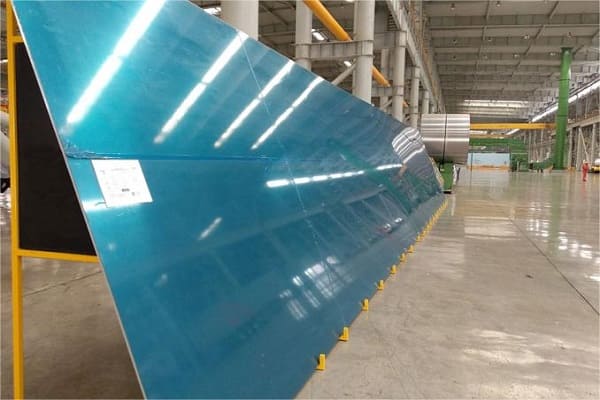Эмне 5086 алюминий барак класс?
5086 алюминий табак бири болуп саналат 5000 сериясы (5xxx сериясы) жогорку коррозияга туруктуулугу менен. 5086 алюминий табак магний металл жогорку мазмуну менен дат-далил алюминий болуп саналат. Ал жогорку коррозияга туруктуулукту жана жакшы ширетүүнү талап кылган колдонмолордо кеңири колдонулат. сексуалдык жана орточо интенсивдүү жагдайлар.
 5086 aluminum-plates
5086 aluminum-plates5086 aluminum sheet chemical composition
| Эритме | Mg | Zn | Mn | Of | Cr | Fe | Individual | Total |
| 5086 | 3.5~4.5 | ≤0.25 | 0.20~0.7 | ≤0.15 | 0.05~0.25 | 0.000~0.500 | ≤0.05 | ≤0.15 |
Rust-proof 5086 алюминий барак
Aluminum-magnesium alloys and aluminum-manganese alloys are collectively called anti-rust aluminum, because the alloy components between them increase their anti-corrosion properties. Representatives of aluminum-manganese alloys are 3003 алюминий барак, 3004 алюминий барак, жана 3105 алюминий барак. Aluminum-magnesium alloys are aluminum sheet 5005 5252 5251 5050 5052 5754 5083 5056 5086, жана башкалар. according to the content of magnesium alloy.
Алюминий барак 5086 common thickness specifications
5086-H32 Aluminum Sheet 0.032″
5086-H32 Aluminum Sheet 0.040″
5086-H32 Aluminum Sheet 0.050″
5086-H32 Aluminum Sheet 0.063″
5086-H321 Aluminum Sheet 0.063″
5086-H116 Aluminum Sheet 0.080″
5086-H32 Aluminum Sheet 0.090″
5086-H116 Aluminum Sheet 0.100″
5086-H116 Aluminum Sheet 0.125″
5086-H32 Aluminum Sheet 0.125″
5086-H116 Aluminum Sheet 0.160″
5086-H116 Aluminum Sheet 0.190″
5086-H32 Aluminum Sheet 0.190″
5086-H116 Aluminum Plate 0.250″
5086-H116 Aluminum Plate 0.313″
5086-H116 Aluminum Plate 0.375″
5086-H32 Aluminum Plate 0.375″
5086-H116 Aluminum Plate 0.500″
5086-H32 Aluminum Plate 0.500″
5086-H116 Aluminum Plate 0.625″
5086-H32 Aluminum Plate 0.625″
5086-H116 Aluminum Plate 0.750″
5086-H116 Aluminum Plate 1.000″
5086-H116 Aluminum Plate 1.250″
5086-H116 Aluminum Plate 1.500″
5086-H116 Aluminum Plate 2.000″
5086 aluminum sheet physical properties
тыгыздыгы: 2.66 г/см³ (0.096 lb/in³)
Melting Point: 585°C to 655°C (1085°F to 1215°F)
Жылуулук өткөргүчтүк: 125 W/(m·K) at 25°C (77°F)
Coefficient of Thermal Expansion: 23.8 x 10^-6 /°C (13.2 x 10^-6 /°F) from 20°C to 100°C (68°F to 212°F)
Specific Heat Capacity: 0.89 J/(g·°C) at 25°C (77°F)
Electrical Conductivity: 31.2% IACS (International Annealed Copper Standard) at 20°C (68°F)
Серпилгичтик модулу: 68.9 GPa (10,000 ksi)
What’s the difference between aluminum sheet 5086 жана 5083?
Aluminum alloys 5086 жана 5083 are both marine-grade alloys known for their excellent corrosion resistance in harsh environments, especially marine applications. Бирок, there are some differences between the two, which mainly lie in their mechanical properties and composition:
эритме курамы:
5086 Алюминий эритмеси: The main alloying element of 5086 is magnesium. It also contains small amounts of manganese, chromium and other elements.
5083 Алюминий эритмеси: Like 5086, 5083 is a magnesium alloy, but it also contains large amounts of chromium and trace amounts of manganese and iron.
Strength and mechanical properties:
5086: Generally slightly lower in strength than 5083, but still has good strength and excellent corrosion resistance. It is often selected for applications where weldability and corrosion resistance are critical.
5083: Compared with 5086, it has higher tensile strength and yield strength. It is known for its exceptional strength in harsh marine environments and is commonly used in structures that require high strength, such as the shipbuilding industry.
Ширетүү:
Both alloys are weldable, but 5086 is generally considered easier to weld than 5083. 5086 is known for its good solderability using standard soldering methods, while 5083 may require more specialized soldering techniques to maintain its mechanical properties.
application:
5086: Commonly used in applications requiring moderate strength and high corrosion resistance, such as ship hulls, storage tanks and pressure vessels.
5083: Preferred in applications where higher strength and toughness are critical, such as the construction of naval vessels, cryogenic tanks and structural components.
